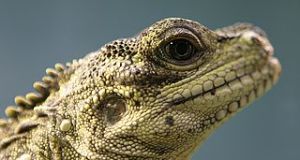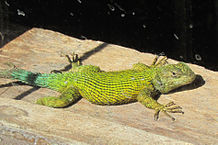 I grew up “knowing” green iguanas to be largely arboreal lizards of thickly-forested habitats. In time, I was able to confirm that impression by observing them high in the canopy of a Costa Rican rainforest, and in the tall trees of Tortuguero Island, Costa Rica…where, in accordance with what I had read, they dove into the river when disturbed.
I grew up “knowing” green iguanas to be largely arboreal lizards of thickly-forested habitats. In time, I was able to confirm that impression by observing them high in the canopy of a Costa Rican rainforest, and in the tall trees of Tortuguero Island, Costa Rica…where, in accordance with what I had read, they dove into the river when disturbed.
 So I was quite surprised, upon arriving in Venezuela’s flat, largely treeless llanos, to find these flooded grasslands well-stocked with the huge lizards. I was there to study green anacondas (also a surprising find, given my past impressions, but we eventually tagged over 500) but found it impossible to limit my attention to them, so overwhelming was the diversity of wildlife.
So I was quite surprised, upon arriving in Venezuela’s flat, largely treeless llanos, to find these flooded grasslands well-stocked with the huge lizards. I was there to study green anacondas (also a surprising find, given my past impressions, but we eventually tagged over 500) but found it impossible to limit my attention to them, so overwhelming was the diversity of wildlife.
The green iguanas grazed on the flat, treeless terrain like so many cows…in fact, they were often among cows, as much of our work was on a cattle ranch. When threatened (i.e. by me trying to catch one), they took off at incredible speeds and dove into the water.
 One stout brute of 5’11” in length (please see photo showing side-view) absolutely refused to enter the water when he reached its edge. He held his ground, thrashing his tail (please see photo showing cut left on my arm by a smaller animal’s tail) and lunging at me. Once subdued, I was able to see that he had numerous old wounds that had likely been inflicted by piranhas, and was missing several toes. Perhaps his stretch of the river had a particularly aggressive piranha population, and he preferred a battle on land to another swim!
One stout brute of 5’11” in length (please see photo showing side-view) absolutely refused to enter the water when he reached its edge. He held his ground, thrashing his tail (please see photo showing cut left on my arm by a smaller animal’s tail) and lunging at me. Once subdued, I was able to see that he had numerous old wounds that had likely been inflicted by piranhas, and was missing several toes. Perhaps his stretch of the river had a particularly aggressive piranha population, and he preferred a battle on land to another swim!
 I’ve included a photo of typical iguana habitat in Venezuela’s central llanos country, to perhaps show you why I was so surprised to find the lizards there (the creatures in the foreground are capybaras, world’s largest rodent). Also included is a photo of another reason that an iguana might choose to run or fight rather than swim – a huge green anaconda basking at the surface.
I’ve included a photo of typical iguana habitat in Venezuela’s central llanos country, to perhaps show you why I was so surprised to find the lizards there (the creatures in the foreground are capybaras, world’s largest rodent). Also included is a photo of another reason that an iguana might choose to run or fight rather than swim – a huge green anaconda basking at the surface.
Today we can see ample evidence of the green iguanas’ adaptability right here in the USA – feral animals live in areas ranging from beaches to suburban gardens throughout south Florida!
Detailed information on green iguana behavior and typical habitats is posted by the Green Iguana Society at:
 That Reptile Blog – Reptile, Amphibian and Exotic Pet Care and Information
That Reptile Blog – Reptile, Amphibian and Exotic Pet Care and Information



